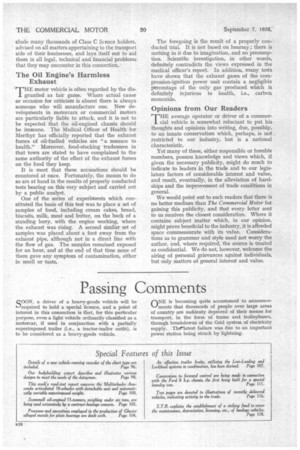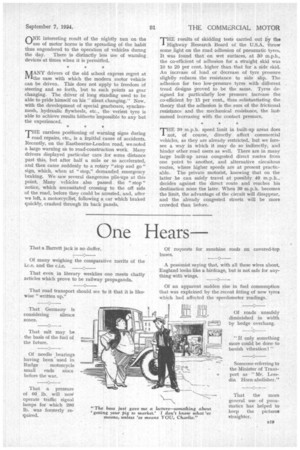Passing Comments
Page 32

Page 33

If you've noticed an error in this article please click here to report it so we can fix it.
S"N'a driver of a heavy-goods vehicle will be required to hold a special licence, and a point of interest in this connection is that, for this particular purpose, even a light vehicle ordinarily classified as a motorcar, if used in conjunction with a partially superimposed trailer (i.e., a tractor-trailer outfit), is to be considered as a heavy-goods vehicle. ONE is becoming quite accustomed to announcements that thousands of people over large areas of country are suddenly deprived of their means for transport, in the form of trams and trolleybuses, through breakdowns of the Grid system of electricity supply. Thenatest failure was due to an important power station being struck by lightning. ONE interesting result of the nightly ban on the 7 use of motor horns is the spreading of the habit thus engendered to the operation of vehicles during
the day. There is distinctly less use of warning devices at times when it is permitted.
MANY drivers of the old school express regret at Vithe ease with which the modern motor vehicle can be driven. This does not apply to freedom of steering and so forth, but to such points as gear changing. The driver of long standing used to be able to pride himself on his' silent changing." Now, with the development of special gea.rboxes, synchromesh, hydraulic flywheels, etc., the veriest tyro is able to achieve results hitherto impossible to any but the experienced.
THE careless positioning of warning signs during
road repairs, etc., is a frilitful cause of accidents. Recently, on the Eastbourne-London road, we noted a large warning as to road-construction work. Many drivers displayed particular care for some distance past this, but after half a mile or so accelerated, and then came suddenly to a rotary "stop and go" sign, which, when at "stop," demanded emergency braking. We saw several dangerous pile-ups at this point. Many vehicles also passed the " stop " notice, which necessitated crossing to the off side of the road, before they could be arrested, and, after we left, a motorcyclist, following a car which braked quickly, crashed through its back panels.
THE results of skidding tests carried out gy the Highway Research Board of the U.S.A. throw some light on the road adhesion of pneumatic tyres. It was found that on wet surfaces, at 80 m.p.h., the co-efficient of adhesion for a straight skid was 10 to 20 per cent, higher than. that for a side skid. An increase of load or decrease of tyre pressure slightly reduces the resistance to side slip. The adhesion for two low-pressure tyres with different tread designs proved to be the same. Tyres designed for particularly low pressure increase the co-efficient by 15 per cent., thus substantiating the theory that the adhesion is the sum of the frictional resistance and the mechanical resistance, the lastnamed increasing with the contact pressure.
THE 30 m.p.h. speed limit in built-up areas does not, of course, directly affect commercial vehicles, as they are already restricted, but we foresee a way in which it may do so indirectly, and hinder other road users as well. There are in many 'large built-up areas congested direct routes from one point to another, and alternative circuitous routes, where higher speeds are at present practicable. The private motorist, knowing that on the latter he can safely travel at possibly 40 m.p.h., decides against the direct route and reaches his destination none the later. When 30 m.p.h. becomes the limit, the advantage of the circuit will disappear, and the already congested streets will be more crowded than before.




























































































